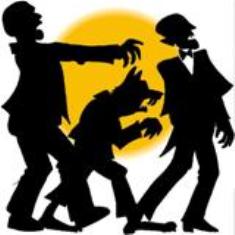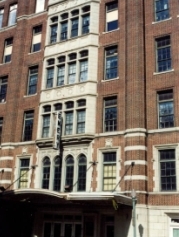
"Frankenstein!!" Comes to the Emery


There was pandemonium at Emery Theater Sunday night
as concert:nova took on the bad boys.
Chief among them was Austrian composer H. K. Gruber
and his 1977 “Frankenstein!!” a one-of-a-kind theater piece that conjures
motley creatures from vampires to sort-of-superheroes. Subtitled “A Pan-demonium for chansonnier
(narrator) and ensemble after children’s rhymes by H.C. Artmann,” it brought
New York cabaret artist Isengart to town for a performance that
bewitched, befuddled and delighted the unsuspecting audience.
It was also just right for Halloween in
spook-ridden, run-down Emery (where laudable efforts at renovation are
nevertheless underway). Opening for
“Frankenstein!!” were works by George Antheil and Paul Hindemith, self-described
“bad boys” (title of Antheil’s autobiography), whose music shook up their
listeners during the 1920s, when Emery was performance home of the Cincinnati
Symphony Orchestra.

The concert was presented in collaboration with the 2012 Constella Festival of Music and Fine Arts, underway until Nov. 6 in Cincinnati. The 12-member concert:nova was led with skill (and good humor) by frequent collaborator, Edwin Outwater, music director of Ontario’s Kitchener-Waterloo Symphony.
Not for nothing did Gruber put two exclamation marks after “Frankenstein!!” (Gruber’s relative Franz Gruber wrote “Silent Night,” by the way.) The 30-minute, eight-part work is performed on conventional and toy instruments, including slide whistles, kazoos, plastic hose pipes, toy piano, etc. The poems on which the tuneful (tonal) music is based are comically horrific -- for adults not children, despite Artmann’s designation.
Isengart was called upon to recite, sing, act and shriek in all kinds of voices. He also had his own cache of toy instruments, including a saxophone. He began as a mouse, one that “nibbles out my eye,” to be replaced by raisins from a currant pie, moving on to “Miss Dracula,” “itzy, bitzy Jimmy Bond,” John Wayne, a werewolf, Superman (about to be snared by Lois Lane in a mousetrap), etc. He was brilliant in all his incarnations, perhaps most remarkably in “Mi Ma Monster,” where he recited deliberately out of sync with the musicians, exploding in a craze of gibberish at the end.
Musically, it was a hoot – Frankenstein danced the tango with “test tube lady” -- and very well played. Percussionist Jerry Noble was kept quite busy throughout the concert, nimbly negotiating mallet instruments, drums, gongs, etc., even popping paper bags. Pianist Julie Spangler also had a toy piano to attend to, cellist Ted Nelson soloed beautifully in “Rat Song and Crusoe Song,” and French hornist Jonas Thoms soared leading into “Batman and Robin.” Half the players rose after “Monster” (a bear gets flushed down a urinal here) to wave plastic hose pipes for a gentle whishing sound. To prolong the comic effect, Isengart and the musicians often paused freeze- frame between movements. The tune everyone took home was the sinister “Rat and Crusoe Song,” sung by Isengart with kazoo accompaniment.
The music was given a visual dimension by artist Peter Haberkorn, whose deliciously apt illustrations were projected onto a screen behind c:n: a bloody human heart for “Miss Dracula,” a skeleton with his hand on a pistol for “Goldfinger and Bond,” Superman disrobing for Lois Lane, Batman and Robin lying on a bouquet of roses, even Cincinnati Art Museum director Aaron Betsky’s book “Building Sex,” bound with a rope (“Monsters in the Park”). All in all, it was an unforgettable evening and begs to be encored next year.
Antheil’s 1925 one-movement Jazz Symphony opened the concert. Though it raises no eyebrows today, it strained boundaries at the time. Heard in its scaled down 1955 version, it made for eight minutes of pleasurable listening, “jazzier” than Gershwin’s contemporary “Rhapsody in Blue,” with a Latin tinge and fine playing by pianist Julie Spangler.
Hindemith’s
Kammermusik No. 1 actually caused a riot when it was performed in Munich in
1923 (reportedly chairs were thrown). How
dare anyone quote a foxtrot in a piece of serious music? Hindemith dared (Doug
Lindsay played it with flair in the finale). The third movement, a lovely “Quartet,” is
scored for three woodwinds plus glockenspiel (one note only!), and the work
ends with a siren. The c:n musicians
gave it a fine, cheeky rendition, full of color and spirit.
(first published in The Cincinnati Enquirer Oct. 23, 2012)